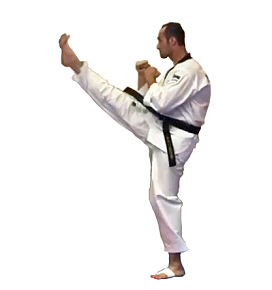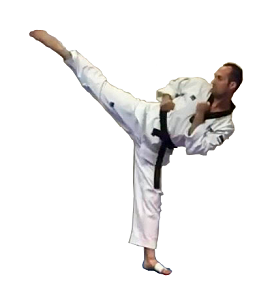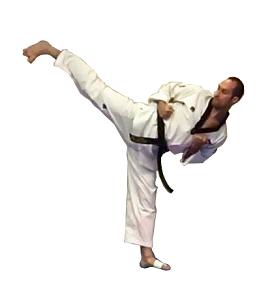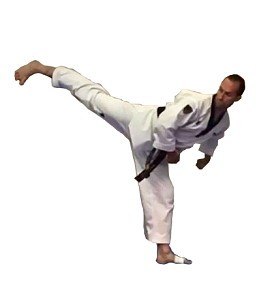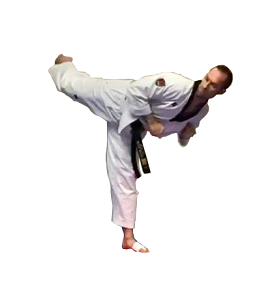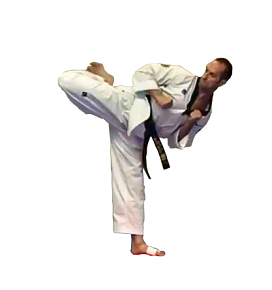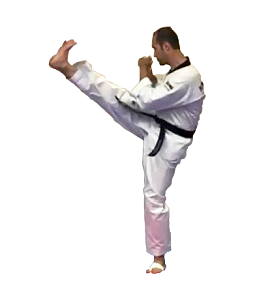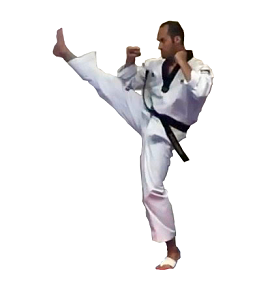Kicking Techniques
Chagi Kisul
차기 기술
There are 10 basic kicks in Kukkiwon Taekwondo, each of which can have one or more modifiers applied to them to adapt the techniques for different variables that arise in a match such as distance and timing.
Anchor Foot Pivot Amounts:
No Pivot
The anchor foot is pointing at 0° relative to the target.Quarter Pivot (Small Pivot)
The anchor foot has turned on the ball of the foot to approximately 45° relative to the target.Half Pivot
The anchor foot has turned on the ball of the foot to approximately 90° relative to the target.Three-Quarter Pivot (Big Pivot)
The anchor foot has turned on the ball of the foot to approximately 135° relative to the target.Full Pivot
The anchor foot has turned on the ball of the foot to approximately 180° relative to the target.
Anchor Foot Pivot Types:
Floor Pivot - The anchor foot turns while still in contact with the floor. A little bit of a heel lift is okay.
Air Pivot - The anchor foot turns while in the air and lands in its end position.
Basic Kicks
기본 차기 기술
The basic version of each kick is performed by the rear leg of the given stance.
Front Kick
Ap Chagi
앞 차기
“Ahp Chah-Gee”
Performed by chambering the leg at chest level then driving the ball of the foot forward into the opponent while the standing foot pivots slightly. Sometimes called a Front Snap Kick.
May also be applied with the sole or heel.
Upward Front Kick / 올려 앞 차기 / Ollyeo Ap Chagi can be used to strike the groin (by striking with the instep) or under the jaw.
Modified Examples:
Lead Front Kick
Ap Bal Ap Chagi
앞 발 앞 차기Twisting Front Kick / Front Cross Kick
Biteureo Ap Chagi / Ap Kkoa Chagi
비틀어 앞 차기 / 앞 꼬아 차기Front Push Kick
Mireo Ap Chagi
밀어 앞 차기
Turning Kick
Dollyeo Chagi
돌려 차기
“Dohl-Leeuh Chah-Gee”
The anchor foot should pivot 135° to 180° immediately after chambering the knee, striking with the instep shortly after the end of the pivot.
May also be applied with the heel, the ball of the foot, or the bottom of the shin bone.
Half Turn Kick / Pan Dollyeo Chagi / 판 돌려 차기 is often utilized in Olympic Kyorugi, where the anchor foot only pivots to around 100° to 130°, delivering a more linear attack.
Short Turn Kick / Jalbeun Dollyeo Chagi / 짧은 돌려 차기 is often utilized in Olympic Kyorugi at clinch range, where the anchor foot pivots a minimal amount while the hips hinge back in order to deliver a kick to the hogu.
Downward Turn Kick / Naeryeo Dollyeo Chagi / 내려 돌려 차기 strikes in a downward arc rather than perpendicular, sometimes called a Question Mark Kick due to the path it travels through the air.
Commonly abbreviated to “Turn Kick”. Also called a Round Kick or Roundhouse Kick by other schools.
Modified Examples:
Tornado Kick
Dolgae Chagi
돌개 차기Fast Turn Kick
Ppaleun Bal Dollyeo Chagi
빠른 발 돌려 차기Triple Turn Kick
Sebeon Narae Chagi
세번 나래 차기
Side Kick
Yeop Chagi
옆 차기
“Yuhp Chah-Gee”
Performed by chambering the knee towards the stomach while pivoting the anchor foot 180°, striking with the heel by driving it into the opponent. The kicker’s ear, shoulder, hip, knee and ankle must form a straight line at maximum kick extension.
Sometimes called a Side Thrust Kick.
May also be applied with the sole, ball (only to extend range when used as a checking or poking motion) or outer blade of the foot.
The Karate technique known as Side Snap Kick / Yoko Geri Keage / 横蹴り 蹴上げ is not present in Kukki Taekwondo, being a largely useless technique in the way it is commonly trained in modern times (directed in a rising fashion to the body or underarm).
Modified Examples:
Flying Side Kick
Ttwieo Yeop Chagi
뛰어 옆 차기Fast Side Kick
Ppaleun Bal Yeop Chagi
빠른 발 옆 차기Back Turning Side Kick
Dwi Dora Yeop Chagi
뒤 돌아 옆 차기
Back Kick
Dwi Chagi
뒤 차기
“Dwee Chah-Gee”
Performed by pivoting the anchor foot 180° while chambering the kicking leg along side the striking leg, driving the heel up towards the opponent with the foot flexed and the toes pointed down. The kicking foot should also “pivot” with the anchor foot to line the hips up, though this happens as it is leaving the floor.
Sometimes superfluously referred to as a “Spinning Back Kick”. It’s actually more of a dorsal turn than a circular spin.
Often mistakenly identified as a Back Turning Side Kick / 뒤 돌아 옆 차기 / Dwi Dora Yeop Chagi, but they aren’t the same thing.
Modified Examples:
Switch Back Kick
Narae Dwi Chagi
나래 뒤 차기Jumping Back Kick
I Dan Dwi Chagi
이 단 뒤 차기Counter Back Kick
Bada Dwi Chagi
받아 뒤 차기
Axe Kick
Naeryeo Chagi
내려 차기
“Neyh-Leeuh Chah-Gee”
Translates to “Downward Kick”.
Performed by chambering the leg at chest level then extending the foot above the face of the opponent, pivoting the anchor foot while driving downward with the heel while the foot is pointed.
May also be applied with the sole of the foot or without a chamber (the leg remains straight on the way up).
Sometimes also called a “Chop Kick”.
Modified Examples:
Outward Axe Kick
Bakkat Naeryeo Chagi
바깥 내려 차기Inward Axe Kick
An Naeryeo Chagi
안 내려 차기Fast Axe Kick
Ppaleun Bal Naeryeo Chagi
빠른 발 내려 차기
Whip Hook Kick
Huryeo Chagi
후려 차기
“Hoo-Leeuh Chah-Gee”
Commonly abbreviated to just “Hook Kick” or “Whip Kick” rather than “Whip Hook Kick”.
Performed by chambering the leg like a side kick then extending the foot approximately 40° beside the target before traveling toward it in an arc, striking with the bottom of the heel while the leg is completely straight then re-chambering the knee either just before or just past the target.
May also be applied with the sole of the foot or the back of the heel.
Spinning Hook Kick / Dwi Huryeo Chagi / 뒤 후려 차기 is the most common form of this kick, which is usually executed as a 180° Hook Kick in modern Olympic Kyorugi rather than as a full spin.
A well executed Whip Hook should strike the target in a side-to-side fashion by using the hip to direct the thigh (and then foot) through the target, which is different from the Scorpion Hook which strikes in a back-to-front fashion by bending the knee to pull the heel toward the body.
Modified Examples:
Spinning Hook Kick
Dwi Huryeo Chagi
뒤 후려 차기180° Hook Kick
180° Dwi Huryeo Chagi
180° 뒤 후려 차기540° Hook Kick
540° Dwi Huryeo Chagi
540° 뒤 후려 차기
Scorpion Hook Kick
Nakka Chagi
낚아 차기
“Nahk-Ah Chah-Gee”
Commonly abbreviated to just “Scorpion Kick” rather than “Scorpion Hook Kick.
Performed by pulling the heel through the target after the leg has extended past. Common targets include the back of the opponent's head, neck and knee. In Olympic Kyorugi it also is used to the body from the clinch position.
May also be applied with the sole of the foot.
A well executed Scorpion Hook strikes in a back-to-front fashion by bending the knee to pull the heel toward the body, which is different from the Whip Hook which strikes the target in a side-to-side fashion by using the hip to direct the thigh (and then foot) through the target.
Modified Examples:
Lead Scorpion Kick
Ap Bal Nakka Chagi
앞 발 낚아 차기Spinning Scorpion Kick
Dwi Nakka Chagi
뒤 낚아 차기Grabbing Scorpion Kick
Japgo Nakka Chagi
잡고 낚아 차기
Twisting Kick
Biteureo Chagi
비틀어 차기
“Bee-Toor-Uh Chah-Gee”
Commonly abbreviated to just “Twist Kick”.
Performed by chambering the leg folded horizontally then twisting the upper body in the opposite direction of the strike while extending the instep outward to the opponent.
May also be applied with the ball of the foot.
It should have the feeling of a Front Kick being directed in a different direction than the body is turning.
Modified Examples:
Lead Twist Kick
Ap Bal Biteureo Chagi
앞 발 비틀어 차기Fast Twist Kick
Ppaleun Bal Biteureo Chagi
빠른 발 비틀어 차기Switch Twist Kick
Narae Biteureo Chagi
나래 비틀어 차기
Inward Crescent Kick
An Chagi
안 차기
“Ahn Chah-Gee”
Commonly abbreviated to just “Inward Kick”.
Performed by chambering the leg similar to a front kick while the foot draws a circle from outside to inside, striking with the inner blade of the foot. The anchor foot pivots to facilitate striking through the opponent's face.
Alternate versions include keeping the leg straight throughout or bending the leg before impact at close range.
Modified Examples:
Lead Inward Kick
Ap Bal An Chagi
앞 발 안 차기Target Inward Kick
Pyojeok An Chagi
표적 안 차기Tornado Inward Kick
Dolgae An Chagi
돌개 안 차기
Outward Crescent Kick
Bakkat Chagi
바깥 차기
“Bah-Kaht Chah-Gee”
Commonly abbreviated to just “Outward Kick”.
Performed by chambering the leg similar to a front kick while the foot draws a circle from inside to outside, striking with the outer blade of the foot. The anchor foot pivots to facilitate striking through the opponent's face.
Alternate versions include keeping the leg straight throughout or bending the leg before impact at close range.
Modified Examples:
Lead Outward Kick
Ap Bal Bakkat Chagi
앞 발 바깥 차기Fast Outward Kick
Ppaleun Bal Bakkat Chagi
빠른 발 바깥 차기Spinning Outward Kick
Dwi Dora Bakkat Chagi
뒤 돌아 바깥 차기
Kick Modifiers
특수 차기 기술
Basic Kicks can have one or more modifiers applied to adapt to a variety of situations. The kick name changes to reflect the modifier(s) applied.
This is by no means a comprehensive list.
Front Foot
Ap Bal Chagi
앞 발 차기
“Ahp Bahl Chah-Gee”
Also called a Lead Kick.
Performed by chambering, kicking and re-chambering the front leg while the anchor foot stays in position, only providing a pivot if necessary.
Can be paired with a Front Cross Stance / Ap Kkoa Seogi / 앞 꼬아 서기 prior to kicking.
Examples:
Lead Front Kick
Ap Bal Ap Chagi
앞 발 앞 차기Lead Turn Kick
Ap Bal Dollyeo Chagi
앞 발 돌려 차기Lead Side Kick
Ap Bal Yeop Chagi
앞 발 옆 차기
Fast Kick
Ppaleun Bal Chagi
빠른 발 차기
“Pah-Loon Bahl Chah-Gee”
Performed by driving the rear foot forward while chambering the front leg to deliver the kicking technique with the front foot while landing the supporting foot. An aerial pivot or a turning (grounded) pivot may be applied depending on the kick.
Also called Bal Butyeo Chagi / 발 붙여 차기 / “Bahl Boot-Yoh Chah-Gee”
Travel → Chamber → Kick
Examples:
Fast Front Kick
Ppaleun Bal Ap Chagi
빠른 발 앞 차기Fast Turn Kick
Ppaleun Bal Dollyeo Chagi
빠른 발 돌려 차기Fast Double Turn Kick
Ppaleun Bal Narae Chagi
빠른 발 나래 차기
Change Kick
Bakkum Bal Chagi
바꿈 발 차기
“Bah-Koom Bahl Chah-Gee”
Performed by changing your stance (left stance to right stance / right stance to left stance) prior to attacking.
Examples:
Change Back Kick
Bakkum Bal Dwi Chagi
바꿈 발 뒤 차기Change Turn Kick
Bakkum Bal Dollyeo Chagi
바꿈 발 돌려 차기Change Axe Kick
Bakkum Bal Naeryeo Chagi
바꿈 발 내려 차기
Switch Kick
Narae Chagi
나래 차기
“Nah-Leyh Chah-Gee”
Most commonly used as a Double Turn Kick; performed by kicking two or more times with alternating legs, using the landing force of one kick to explode into the next via a switch of the feet rather than a jump.
By default the first technique is done with the rear leg but other modifiers like Fast Kick (Fast Switch Kick) or Lead Kick (Lead Switch Kick) can also be applied to the Switch action.
If listed as just “Narae Chagi” it refers to a Double Turn Kick.
Examples:
Switch Turn Kick
Narae Dollyeo Chagi
나래 돌려 차기Fast Double Turn Kick
Ppaleun Bal Narae Chagi
빠른 발 나래 차기Switch Back Kick
Narae Dwi Chagi
나래 뒤 차기
Counter Kick
Bada Chagi
받아 차기
“Bahd-Ah Chah-Gee”
Performed by executing a kick simultaneously or near-simultaneously with that of the opponent's, with the swinging direction of the counter attack being complimentary of that of the attacker's.
Can also be used in a non-counter manner as a method of scoring from close range. The anchor foot’s amount of reposition will depend on the distance from the target.
Lifting the anchor foot before repositioning it can provide a Switch Kick feel to the technique.
Examples:
Counter Turn Kick
Bada Dollyeo Chagi
받아 돌려 차기Counter Back Kick
Bada Dwi Chagi
받아 뒤 차기Counter Spinning Hook Kick
Bada Dwi Huryeo Chagi
받아 뒤 후려 차기
Tornado Kick
Dolgae Chagi
돌개 차기
“Dohl-Geyh Chah-Gee”
Performed by executing a 360° back turn via simultaneous foot pivot (“double pivot”) to increase the force of the kicking technique. By default a Turn Kick, other versions include Tornado Axe Kick, Tornado Front Kick, etc. It can best be thought of as a back turn into a chamber feint followed by a Narae Chagi / Switch Kick.
Demonstration, breaking, and Freestyle Poomsae versions are different than kyorugi / sparring versions.
Examples:
Tornado Kick
Dolgae Chagi
돌개 차기Tornado Axe Kick
Dolgae Naeryeo Chagi
돌개 내려 차기Tornado Side Kick
Dolgae Yeop Chagi
돌개 옆 차기
Cut Kick
Keoteu Chagi
커트 차기
“Kuh-Too Chah-Gee”
Performed by lifting the kicking leg up and forward while driving the anchor leg towards the opponent. A side kick by default. Used to damage, reposition or check the opponent. A vital technique for entrance.
“Keoteu” is a loan word — the word “cut” loaned from English to Korean and sounded out phonetically in Hangul.
Kukkiwon calls this a Kkeureo Chagi / 끌어 차기 / Dragging Kick, but everyone pretty much calls it a Cut Kick.
Chamber → Travel → Kick
Examples:
Cut Kick
Keoteu Chagi
커트 차기Cut Turn Kick
Keoteu Dollyeo Chagi
커트 돌려 차기Cut Axe Kick
Keoteu Naeryeo Chagi
커트 내려 차기
Fast Switch Kick
Ppaleun Narae Chagi
빠른 나래 차기
“Pah-Loon Nah-Leyh Chah-Gee”
Performed by feinting a Ppaleun Bal Chagi / Fast Kick with the front leg before switching into the actual attack with the rear leg. The type of Fast Kick feinted will be dependent on the actual attack.
You can also do multiple chamber switches per action before finishing with an attack.
Sometimes called a Skipping Kick.
Examples:
Fast Switch Turn Kick
Ppaleun Narae Dollyeo Chagi
빠른 나래 돌려 차기Fast Switch Back Kick
Ppaleun Narae Dwi Chagi
빠른 나래 뒤 차기Fast Switch Inward Kick
Ppaleun Narae An Chagi
빠른 나래 안 차기
Repeating Kick
Geodeup Chagi
거듭 차기
“Guh-Doob Chah-Gee”
Performed by executing two or more kicks immediately after one another while not allowing the foot to touch the floor in between. Keeping the chambered knee high throughout each kick is vital.
Commonly used to strike a different body part per kick, such as delivering a Side Kick to the opponent’s knee then re-chambering and delivering a second Side Kick to their face as in Poomsae Koryo.
Examples:
Repeating Front Kick
Geodeup Ap Chagi
거듭 앞 차기Repeating Turn Kick
Geodeup Dollyeo Chagi
거듭 돌려 차기Repeating Side Kick
Geodeup Yeop Chagi
거듭 옆 차기
Mixed Kick
Seokkeo Chagi
섞어 차기
“Suhk-Uh Chah-Gee”
Repeating Kick / Geodeup Chagi technically repeats the same kicking technique while Mixed Kick / Seokkeo Chagi refers to doing two or more different types of kick with the same leg before setting the foot down.
Commonly used to strike a different body part per kick, Cut Kick → Mix High Turn Kick, for example, (usually abbreviated as “Cut → Mix High Turn”) would be executing a Cut Kick for the opponent’s body and then re-chambering and doing a Turn Kick to their face before setting the attacking foot back down.
Examples:
Cut Kick → Mix Turn Kick
Keoteu Chago → Seokkeo Dollyeo Chagi
커트 차고 → 섞어 돌려 차기Inward Kick → Mix Side Kick
An Chago → Seokkeo Yeop Chagi
안 차고 → 섞어 옆 차기Back Kick → Mix Hook Kick
Dwi Chago → Seokkeo Huryeo Chagi
뒤 차고 → 섞어 후려 차기
Pushing Kick
Mireo Chagi
밀어 차기
“Meel-Uh Chah-Gee”
Performed by extending the kicking leg slightly before or as you place the sole of the foot on the opponent to deliver pushing force rather than a strike. Is often accompanied by a forward leap of the anchor foot timed with the extension of the pushing foot.
Front Push Kick and Lead Side Push Kick are the most common examples.
Examples:
Front Push Kick
Mireo Ap Chagi
밀어 앞 차기Side Push Kick
Mireo Yeop Chagi
밀어 옆 차기Lead Front Push Kick
Ap Bal Mireo Ap Chagi
앞 발 밀어 앞 차기
Grabbing Kick
Japgo Chagi
잡고 차기
“Jahp-Goh Chah-Gee”
Performed by grabbing onto the opponent’s arm, clothing, etc. and holding them in place or bringing them into a kicking technique.
Examples:
Grabbing Side Kick
Japgo Yeop Chagi
잡고 옆 차기Grabbing Turn Kick
Japgo Dollyeo Chagi
잡고 돌려 차기Grabbing Scorpion Kick
Japgo Nakka Chagi
잡고 낚아 차기
Flying Kick
Ttwieo Chagi
뛰어 차기
“Twee-Uh Chah-Gee”
Performed by running then jumping and executing the kick in mid-air. The actual kicking technique is performed the same as if it is being done on the ground.
Primarily used in demonstration, breaking and Freestyle Poomsae.
Examples:
Flying Side Kick
Ttwieo Yeop Chagi
뛰어 옆 차기Flying Back Kick
Ttwieo Dwi Chagi
뛰어 뒤 차기Flying Axe Kick
Ttwieo Naeryeo Chagi
뛰어 내려 차기
Jumping Kick
I Dan Chagi
이 단 차기
“Ee-Dahn Chah-Gee”
I Dan means 2nd Level, which in this case means to jump up from a standing position.
Performed by jumping up, forward or backward while executing a kick, typically with the rear leg though Jumping Lead Kick / I Dan Ap Bal Chagi exists as well.
Sometimes Ttwieo Chagi is used for Jumping Kicks instead of I Dan Chagi.
Examples:
Jumping Turn Kick
I Dan Dollyeo Chagi
이 단 돌려 차기Jumping Back Kick
I Dan Dwi Chagi
이 단 뒤 차기Jumping Spinning Hook Kick
I Dan Dwi Huryeo Chagi
이 단 뒤 후려 차기
Stomping Kick
Gulleo Chagi
굴러 차기
“Gool-Luh Chah-Gee”
Similar to a Fast Kick / Ppaleun Bal Chagi, the front foot is lifted then stomps the floor before the rear foot travels.
The rebounding force of the front foot stomp should be used as a plyometric force to add power to the technique. The lift and stomp can also be used as a feint.
Stomp → Travel → Chamber → Kick
Examples:
Stomping Turn Kick
Gulleo Dollyeo Chagi
굴러 돌려 차기Stomping Side Kick
Gulleo Yeop Chagi
굴러 옆 차기Stomping Axe Kick
Gulleo Naeryeo Chagi
굴러 내려 차기
Target Kick
Pyojeok Chagi
표적 차기
“Peeoh-Juhg Chah-Gee”
Similar to a Grabbing Kick / Japgo Chagi, which often grabs the arm or clothing of the opponent, the Target Kick grabs their head from the side or back, or the hair, and holds it there while a kick is thrown towards the face.
Examples:
Target Inward Kick
Pyojeok An Chagi
표적 안 차기Target Outward Kick
Pyojeok Bakkat Chagi
표적 바깥 차기Target Scorpion Kick
Pyojeok Nakka Chagi
표적 낚아 차기
Scissor Kick
Gawi Chagi
가위 차기
“Gah-Wee Chah-Gee”
A flying kick where each leg is kicking in a different direction. Typically a Side Kick / Yeop Chagi is paired with a Twist Kick / Biteureo Chagi.
Used in fight choreography, demonstrations, breaking and Freestyle Poomsae.
360° Kick
360° Chagi
360° 차기
“360° Chah-Gee”
Used in kyorugi, fight choreography, demonstrations and Freestyle Poomsae.
Performed by doing a feint with the rear leg, completing the first 180°, before doing a back turn to switch into an attack with the other leg, adding another 180° of rotation. The feint will be different depending on the situation.
Can be done with the feeling of a Jumping/Flying Kick or with the feeling of a Switch Kick.
Commonly used as a 360° Spinning Hook Kick, 360° Back Kick or 360° Turning Side Kick.
360 = Sambaeg-yugsip = 삼백육십
Examples:
360° Hook Kick
360° Dwi Huryeo Chagi
360° 뒤 후려 차기360° Back Kick
360° Dwi Chagi
360° 뒤 차기360° Turning Side Kick
360° Dwi Dora Yeop Chagi
360° 뒤 돌아 옆 차기
540°, 720°, 900° Kick
540°, 720°, 900° Chagi
540°, 720°, 900° 차기
“540°, 720°, 900° Chah-Gee”
Used in demonstrations, breaking, and Freestyle Poomsae. The body turns the prescribed number of degrees prior to executing the chosen kick type. 540° Hook Kicks do pop up in Olympic style competition every now and then, though, and sometimes they’re successful.
Examples:
540° Hook Kick
540° Dwi Huryeo Chagi
540° 뒤 후려 차기720° Tornado Kick
720° Dolgae Chagi
720° 돌개 차기900° Hook Kick
900° Dwi Huryeo Chagi
900° 뒤 후려 차기
Power Kick
Taeryeok Chagi
태력 차기
“Teyh-Reeuhk Chah-Gee”
A technique where the anchor foot moves forward at the same time that the kicking foot leaves the floor, covering more space and striking with more power. It is important to remember that you should push your feet down through the floor in order to generate a reactionary force.
Sometimes written as Taeryuk, such as in the case of 이동희 Master Lee Dong Hee’s World Kangjin Taekwondo.
Examples:
Power Turn Kick
Taeryeok Dollyeo Chagi
태력 돌려 차기Power Front Kick
Taeryeok Ap Chagi
태력 앞 차기Power Side Kick
Taeryeok Yeop Chagi
태력 옆 차기
Stomp
Jitjjihgi
짓찧기
“Jeet-Chjeeh-Gee”
Performed by driving the heel of your foot down onto your opponent. The chamber and extension should mirror that of a Side Kick aimed downward.
Examples:
Instep Stomp
Bal Deung Jitjjihgi
발 등 짓찧기Solar Plexus Stomp
Myeongchi Jitjjihgi
명치 짓찧기Head Stomp
Dugaegol Jitjjihgi
두개골 짓찧기

